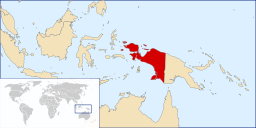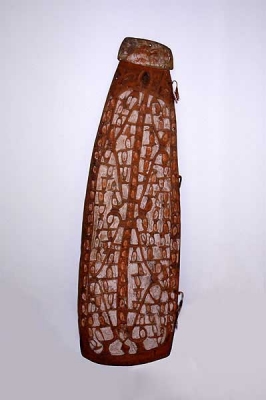Asmat shield (1970.18.1)
 West PapuaAsmat shield from Irian Jaya (West Papua), Asia. Made by an Asmat carver called 'Sana'. Collector not known. Purchased by the Museum from the Asmat Art Depot, Rotterdam in 1970.
West PapuaAsmat shield from Irian Jaya (West Papua), Asia. Made by an Asmat carver called 'Sana'. Collector not known. Purchased by the Museum from the Asmat Art Depot, Rotterdam in 1970.
This carved rectangular wooden shield is over 1.5 metres long and known as a jamasj among the Asmat. The Asmat are an ethnic group of the western, Indonesian part of New Guinea also known as West Papua and, in the past, Irian Jaya.
The Asmat possess, in addition to a historical tradition of head-hunting, one of the most well-known and vibrant woodcarving traditions in the Pacific. Asmat artistic objects, such as this shield, are now often made specifically for sale and are sought after by collectors worldwide.
Very large shields like this were also functional and were stood on end in battle, propped against the left shoulder, while the warrior used his bow and arrow from behind them.
Defining Gender
Jamasj (shields) were among the most highly valued of Asmat artefacts and relate to concepts of masculinity. Shields were always carried by men and were thought to embody one of the owner's dead male relatives. When a man went into battle, he went to avenge the death of the relative embodied in his shield and that relative went with him to assist. Similarly, before a head-hunting mission, shields were carved and presented to the warriors at a Jamasj Pokmbu (Shield Feast). At this feast, the shields were stood to face east, the direction of Safan (the Asmat afterlife), from which the spirit returned to enter the shield.
The decoration on the surface is considered to be a depiction of the spirit it contains. The central, elongated motif is called bipanew, and represents the pearl-shell ornament that an Asmat head-hunter wore through the pierced septum of his nose. The smaller hooked motifs indicate the tusk of a wild boar, a dangerous animal associated with masculine qualities. This example was carved by a man named Sana and is named after his dead brother, Hadmes (the top panel may represent Hadmes' face in abstract).
Shields such as this were associated with the taking of enemy heads. Although headhunting no longer continues, historically the practice was considered vital to the Asmat for several reasons. One's decapitated relatives demanded revenge, and caused a man misery until he avenged them. Similarly, until a man sought revenge, he was widely ridiculed by those around him and could not find a wife. The Asmat, living in regions of mangrove, rainforest and swamps, are highly dependent on their environment. Since heads were perceived to ensure the community's agricultural fertility, they were hung up in the sago palm plantations to magically fertilise them. Heads also played a central part in boys' initiation rituals, where each boy became the reincarnation of an enemy victim, whose head he had been given. He carried the deceased's name for the rest of his life, and was even viewed as the deceased by the victim's relatives.





